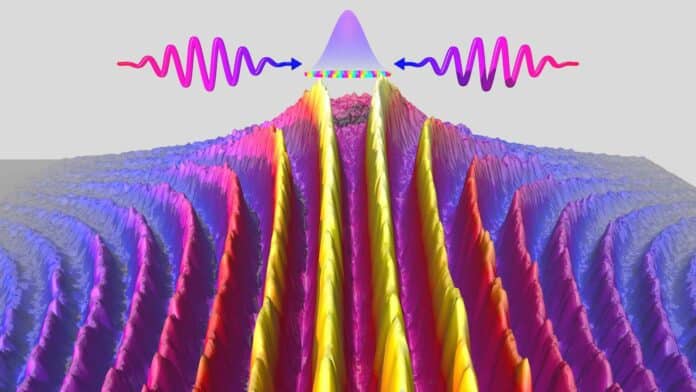The interaction between electrons and light is the most fundamental interaction in physics. Scientists from Goethe University Frankfurt performed an experiment in which they observed the Kapitza-Dirac effect for the first time in full temporal resolution.
First postulated almost nine decades ago, the Kapitza–Dirac effect is a quantum mechanical effect consisting of the diffraction of matter by a standing wave of light. In its original description, the effect is time-independent.
In this study, scientists extended the Kapitza-Dirac effect to the time domain. Using this effect, scientists visualize even the temporal evolution of the electron waves, known as the electrons’ quantum mechanical phase.
Scientists fired two ultrashort laser pulses from opposite directions at a xenon gas. These femtosecond pulses, defined as a quadrillionth (one-millionth of one billionth) of a second, created an ultrastrong light field at the crossover point for brief intervals. This caused the xenon atoms to become ionized—that is, to lose their electrons.
The electrons released in this manner also created a standing wave at the center, and very soon after, the physicists fired a second pair of brief laser pulses at them. These pulses didn’t ionize any more material and were a little weaker. Nevertheless, they may now interact with the free electrons, as demonstrated by a Frankfurt-developed COLTRIMS reaction microscope.
At the point of interaction, three things can happen: either the electron does not interact with the light, or it is scattered to the left or to the right.
These three scenarios add up to a specific probability represented in the electrons’ wave function and are determined by the laws of quantum physics: The electron, with a certain probability, is likely to be in a cloud-like region that collapses into three-dimensional slices. In this case, the time between ionization and the second pair of laser pulses’ moment of impact determines the temporal evolution of the wave function and its phase.
Dörner said, “This opens up many exciting applications in quantum physics. Hopefully, it will help us track how electrons transform from quantum particles into completely normal particles within the shortest time. We are planning to use it to learn more about the entanglement between different particles that Einstein called ‘spooky.'”
“As so often in science, putting long-established theories to the test repeatedly has been worthwhile here, too.”
Journal Reference:
- Kang Lin, Sebastian Eckart, Hao Liang, Alexander Hartung, Sina Jacob, Qinying Ji, Lothar Ph. H. Schmidt, Markus S. Schöffler, Till Jahnke, Maksim Kunitski, Reinhard Dörner: Ultrafast Kapitza-Dirac effect. Science (2024). DOI: 10.1126/science.adn1555
